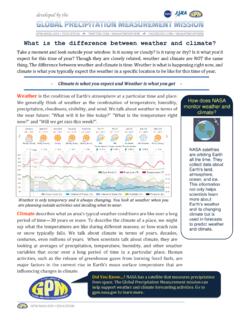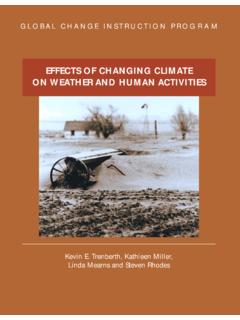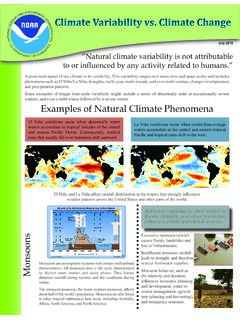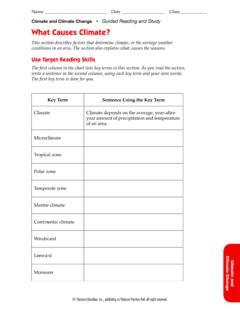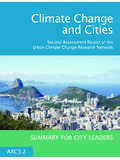Transcription of Climate-Smart Agricultutre training manual
1 Climate-Smart AGRICULTURETRAINING MANUALA reference manual for agricultural extension agentsEconomic and Policy Analysis of climate Change (EPIC)Agricultural Development Economics Division (ESA) Food and Agriculture Organization of the United Nations (FAO)Viale delle Terme di Caracalla, 00153 Rome, 978-92-5-131065-6978 9251310656 Climate-Smart AGRICULTURE T R A I N I N G M A N U A L A reference manual for agricultural extension agentsFAOTRAINING MANUALA reference manual for agricultural extension agentsCLIMATE-SMART AGRICULTURECLIMATE-SMART AGRICULTURETRAINING MANUALA reference manual for agricultural extension agentsFood and Agriculture Organization of the United NationsRome.
2 2018 The designations employed and the presentation of material in this information product do not imply the expression of any opinion whatsoever on the part of the Food and Agriculture Organization of the United Nations (FAO) concerning the legal or development status of any country, territory, city or area or of its authorities, or concerning the delimitation of its frontiers or boundaries. The mention of specific companies or products of manufacturers, whether or not these have been patented, does not imply that these have been endorsed or recommended by FAO in preference to others of a similar nature that are not views expressed in this information product are those of the author(s) and do not necessarily reflect the views or policies of 978-92-5-131065-6 FAO, 2018 Some rights reserved.
3 This work is made available under the Creative Commons Attribution-NonCommercial-ShareAlike IGO licence (CC BY-NC-SA IGO; ). Under the terms of this licence, this work may be copied, redistributed and adapted for non-commercial purposes, provided that the work is appropriately cited. In any use of this work, there should be no suggestion that FAO endorses any specific organization, products or services. The use of the FAO logo is not permitted. If the work is adapted, then it must be licensed under the same or equivalent Creative Commons license.
4 If a translation of this work is created, it must include the following disclaimer along with the required citation: This translation was not created by the Food and Agriculture Organization of the United Nations (FAO). FAO is not responsible for the content or accuracy of this translation. The original [Language] edition shall be the authoritative mediation relating to disputes arising under the licence shall be conducted in accordance with the Arbitration Rules of the United Nations Commission on International Trade Law (UNCITRAL) as at present in materials.
5 Users wishing to reuse material from this work that is attributed to a third party, such as tables, figures or images, are responsible for determining whether permission is needed for that reuse and for obtaining permission from the copyright holder. The risk of claims resulting from infringement of any third-party-owned component in the work rests solely with the , rights and licensing. FAO information products are available on the FAO website ( ) and can be purchased through Requests for commercial use should be submitted via: Queries regarding rights and licensing should be submitted to: photos clockwise: FAO/Dante Diosina; FAO/Hoang Dinh Nam; FAO/Olivier citation:FAO.
6 2018. Climate-Smart agriculture training manual A reference manual for agricultural extension agents. Rome. 106 pp. Licence: CC BY-NC-SA AGRICULTURE training MANUALiiiContentsAcknowledgements viiiAcronyms ixINTRODUCTION 1 Module A Understanding climate change 5 Session A1.
7 What is climate change? 6 Session A2. Causes of climate change 15 Module B climate change impacts on agriculture and food security 21 Session B1. climate change and agriculture 22 Session B2. climate change and food security 34 Module C Climate-Smart agriculture 46 Session C1. Climate-Smart agriculture definition and characteristics 47 Session C2. Gender issues in Climate-Smart agriculture 59 Module D Climate-Smart agriculture solutions for your area 70 Session D1. Local Climate-Smart practices 71 Session D2. Barriers and opportunities 81 REFERENCES 92 Climate-Smart AGRICULTURE training MANUALivExercisesExercise Introduction to the training course 18 Exercise weather and climate 18 Exercise Global Warming 18 Exercise Changes in rainfall 18 Exercise The greenhouse effect 19 Exercise climate change in your area 19 Exercise Understanding the effects of future climate change 43 Exercise Effects of climate change 43 Exercise The greenhouse effect 43 Exercise Comparing countries greenhouse gas emissions
8 44 Exercise Virtual field visits to observe activities that release greenhouse gases 44 Exercise What is food security? 45 Exercise What causes food insecurity? 45 Exercise climate change and food security 45 Exercise Adaptation and mitigation 65 Exercise Climate-Smart agriculture 65 Exercise Current agricultural practices 66 Exercise Are current practices Climate-Smart ? 66 Exercise Making agricultural practices more Climate-Smart 67 Exercise Prioritizing options 67 Exercise Gender and climate change 67 Exercise World caf on Climate-Smart agricultural practices 89 Exercise Other local Climate-Smart practices 89 Exercise Barriers and opportunities to adopting Climate-Smart agriculture 89 Exercise Risk management 90 Exercise Action planning 90 Exercise Close
9 91 Climate-Smart AGRICULTURE training MANUALvTablesTable 1. Outline of the training course 2 Table B1. Examples of effects of climate change on several aspects of human life and ecosystems 22 Table B2. Example of projected climate change effects on crop production 25 Table B3. Main sources of greenhouse gas emissions from agriculture 27 Table BV1. Greenhouse gas emission projection by sector (in million tonnes CO2-eq) 32 Table B4. The four dimensions of food security 34 Table B5.
10 The duration dimension: chronic versus transitory food insecurity 36 Table B6. Types of climate -related risks and potential impacts on agricultural producers 40 Table BZ1. Examples of how heavy rain affects food security in Zambia 42 Table B7. Greenhouse gas emissions by country (including LULUCF) 44 Table C1. Comparing current agricultural practices and Climate-Smart agriculture 49 Table C2. Description of some sustainable agricultural practices 51 Table C3. Sample options for adaptation to climate change at farm level 52 Table C4.











